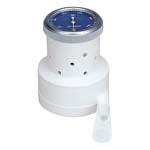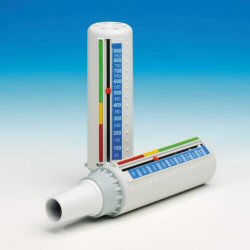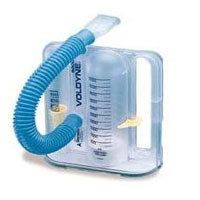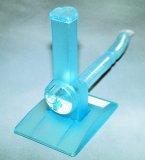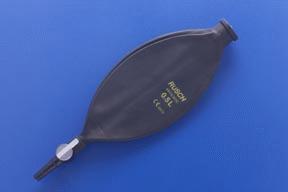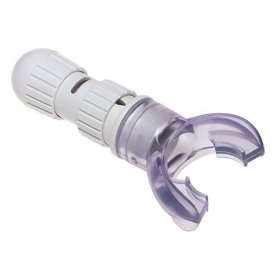RESPIRATORY TRAINING FOR MUSICIANS
Will Kimball, Brigham Young University
For wind instruments, one of the most important factors in tone production is the use of air. Airflow in wind instruments can be roughly compared to bowing technique in string instruments or stick technique in percussion, since it is the element that prompts the vibration which leads to sound.
Medical research has shown that the three most important predictors of lung capacity (and many aspects of lung function, or the way we are able to use our lung capacity) are age, height, and gender. Although all three of these predictors are outside of our voluntary control, lung function and lung capacity are actually not entirely fixed. A growing body of medical literature has shown that they can be affected significantly through training.
There are many exercises that have been designed over the years to help wind instrumentalists improve their use of air (often termed “air support” or “control”). One of the interesting new developments in this area has followed the lead of the medical field in what is called “respiratory training.” Respiratory training is based on the medically-documented concepts that 1) the respiratory system is driven by what are called “skeletal” muscles, and 2) skeletal muscles can be strengthened through training.
Arnold Jacobs, former tubist with the Chicago Symphony and world-renowned breathing specialist, was one of the first major figures in the music field to take advantage of respiratory training tools, which he used regularly in clinics and his private teaching. There are now a number of major music distributors that offer many of the same tools, as well as other tools that have become available through the medical community.
Below is a review of some of the medical research that has been done on respiratory training, followed by a discussion of applications for musicians and an introduction to some of the training tools.
A brief note about terminology: In the medical field, the term inspiration is synonymous with inhalation, and expiration with exhalation. Lung volume is divided into several categories, but vital capacity (the maximum amount of air a person can voluntarily exhale after a maximal inhalation), is the most applicable to musicians. Respiratory flow refers simply to movement of air; when musicians work on improving flow, they are simply trying to improve the amount of air they move or the speed with which they move it. This can affect phrase length, tone, and dynamics. Respiratory pressure refers to the ability of instruments more than others but is a factor in the high register for brass, particularly trumpet and horn. More specific applications of flow and pressure are discussed below, under the heading “Applications for Musicians.”
THE MEDICAL STUDIES
Vital Capacity: As early as 1949, University of Cambridge physiologist J. N. Mills, writing in the Journal of Physiology, demonstrated that subjects were able to increase their vital capacity over time through repeated vital capacity maneuvers (taking the biggest breath possible). One subject increased his vital capacity, for example, by almost one full liter over a 9-month period, while another increased vital capacity by nearly ½ liter over a period of only 18 days.
Vital Capacity: The same year, Gilson and Hugh-Jones published research on breathing measurements in the journal Clinical Science. In their study, the vital capacity of one subject was measured 400 times over the course of three weeks. The averages of the first, second, third, and fourth hundred readings were found to be increasingly greater: 6.31, 6.36, 6.40, and 6.41, indicating that the simple act of repeating a large number of vital capacity breaths over a concentrated amount of time can actually lead to an increased capacity. The breaths included visual feedback, an ingredient present in many of the studies, thought by researchers to be particularly helpful in “effort-dependant” maneuvers. Gilson and Hugh-Jones concluded in their study that “the actual vital capacity of an individual is not a constant quantity” as had previously been supposed.
Vital Capacity and Respiratory Strength: Later, a study by David Leith and Mark Bradley of Harvard University demonstrated that other parameters of respiratory function could be affected by training as well. They based their study, which was published in 1976 in the Journal of Applied Physiology, on the hypothesis that “accepted principles of skeletal muscle training” apply to the respiratory system. A group performing “strength training” executed both inspiratory and expiratory maneuvers against high resistance for 30 minutes a day. At the end of the five-week training period, the strength of their inspiratory and expiratory muscles had increased by an average of approximately 55 percent. Their vital capacity also increased by an average of 4 percent over the same period.
Vital Capacity and Inspiratory Pressure: In a related study led by Christopher Fanta and conducted jointly at Boston area hospitals and Harvard University in 1983, an experimental group of healthy volunteers was able to increase their vital capacity by an average of 200 ml over six weeks by completing a daily routine of 20 maximal inhalations, held each time for ten seconds with the glottis open. Maximal inspiratory pressure also increased significantly in the training group. Subjects in a control group who received no training showed no significant change in breathing measurements. The authors conclude, “In summary, we have found that normal adult volunteers can significantly enlarge their vital capacity and total lung capacity (in 6 weeks) by performing inspiratory muscle exercises.”
Inspiratory Pressure, Inspiratory Flow, and Training Specificity: In 1994, physiologist George Tzelepis headed two important studies, both published in the Journal of Applied of Physiology (1, 2), at the Chicago Medical School and Veterans Affairs Medical Center. In the first study, a group that performed maximal inspiratory efforts against high resistance for five weeks (30 minutes a day, 5 days a week) experienced a 36 percent increase in inspiratory muscle strength (maximal inspiratory pressure). The training equipment included visual feedback so that subjects were able to see exactly how much pressure they were generating during training efforts. In the second study, three separate groups performed specific training protocols: Group A (pressure training) performed 30 maximal inspiratory maneuvers against high resistance, Group B (flow training) performed 30 sets of 3 maximal inspiratory maneuvers with no resistance daily, Group C (intermediate training) performed 30 maximal inspiratory efforts on a midrange external resistance daily, and a control group, Group D, did measurements with the others but no training. After training five days a week for six weeks, Group A (pressure training) increased maximal pressure by 37 percent, but not maximal flow; Group B (flow training) increased maximal flow by 17 percent, but not maximal pressure; Group C (intermediate training) increased both maximal pressure (17 percent) and maximal flow (14 percent); and Group D (control) showed no improvements. As Tzelepis states, “We found that the greatest increases in pressure occurred with high pressure training, the greatest increases in flow occurred with flow training, and intermediate tasks resulted in a more uniform increase in pressure and flow.” Tzelepis and his fellow researchers were thus able to conclude that there is “specificity of pressure and flow training in the respiratory system,” in accordance with a general principle of muscle training called “force-velocity specificity of training.” In other words, specific types of training will bring about specific types of results.
Neural Adaptations: Tzelepis points out that, in addition to changes in the muscles themselves, there are actually neural adaptations to training that make the muscles more efficient. As is commonly known, muscles normally exist in paired sets of agonists and antagonists—one pushes, the other pulls. In relation to the respiratory muscles, Tzelepis observes, “Excessive cocontraction of antagonists may limit full motor unit activation of agonists, especially during complicated and precise tasks.” That is, muscle groups may sometimes incidentally work against each other, limiting their own success. However, he notes, “With training, the amount of cocontraction is usually reduced, thereby allowing greater activation of agonists and greater net force generation.” In other words, the respiratory muscles, like other skeletal muscles, begin working in a more coordinated, efficient fashion after training.
Inspiratory Pressure, Expiratory Pressure: In 1994, researchers in Tokyo, headed by Dr. Hiroaki Nomori, published similar findings in the journal Chest, the official publication of the American College of Chest Physicians. They found that 50 patients who underwent preoperative respiratory muscle training increased both maximal inspiratory pressure (37 percent) and maximal expiratory pressure (17 percent). A control group of 50 healthy subjects that was matched for age and sex and had no training showed no significant change. The training took place for 40 minutes a day for 14 days and involved a combination of resistance and flow, inspiration and expiration.
Expiratory Pressure on Musicians: Finally, in 2002, in one of the few studies to target musicians, University of Florida researchers, led by Dr. Christine Sapienza, divided 40 high school band students into either an experimental group or a control group. The experimental group participated in a respiratory training program that consisted of 24 breaths per day on a high-resistance expiratory training device. After training five days a week for two weeks, the experimental group saw an average improvement in maximal expiratory pressure of 47.5 percent. The control group saw no improvement.
Summary of Studies: In summary, vital capacity, maximal expiratory pressure, maximal inspiratory flow, and maximal inspiratory pressure can all be improved through respiratory training. These training improvements appear to be brought about through both strengthening of the respiratory muscles and neural adaptations that help better coordinate respiratory maneuvers. There also appears to be some “specificity” of training: flow training generally increases flow but not pressure, while resistance training increases pressure but not flow.
APPLICATIONS FOR MUSICIANS
So which type of training should a musician use? It depends on what the player wishes to improve. If you want to improve flow, studies have shown that you should practice with high-flow, low-resistance exercises. If you wish to improve your ability to generate pressure, research shows you should practice with high-resistance maneuvers. Vital capacity appears to be improved most by practicing a large number of full, vital capacity breaths.
Training for Individual Instruments: Which improvements will have the most positive affects for your specific instrument? Yale physiologist Arend Bouhuys, an amateur musician himself, studied the respiratory physiology of wind musicians extensively. In a study entitled “Pressure-flow Events During Wind Instrument Playing,” published in the Annals of the New York Academy of Sciences, Bouhuys determined mouth pressures and flow rates for most of the major wind instruments. He showed that, in measurable ways, players are limited according to how much flow or pressure they are able to generate. Pressure is a limiting factor because a certain amount of driving pressure is necessary in order to produce vibration on any wind instrument—the specific amount depends on the instrument, dynamics, and pitch. For example, high brass instruments are limited, particularly in their upper register, by the amount of expiratory pressure they are able to generate. (Although emphasis on respiratory pressure is not recommended as a pedagogical approach, it is a scientific fact of life.) Presumably it would then benefit high-pressure instruments to engage in external resistive training. On the other hand, according to Bouhuys, low brass and flute are particularly high flow instruments and are often limited in volume and phrase length by flow. Inspiratory and expiratory flow training would presumably benefit those instruments. Among brass players, Bouhuys showed that there is a rough correlation between flow and size of the instrument, the tuba requiring the highest flow. For all wind instruments, pressure and flow increase with loudness, and for most wind instruments, pressure increases as pitch ascends. Another important consideration is the rapidity with which the inspiration must take place for most wind instruments: players are often required to take in a large amount of air in a very short amount of time. Thus, inspiratory flow training would presumably be beneficial for nearly all wind players. For most wind instruments, improving expiratory flow improves tone, allows the player to relax more, keeps airways more open, and allows greater dynamic freedom. Finally, vital capacity has an obvious limiting affect on wind instruments; anybody who has ever had to break up a long, beautiful phrase with an unmusical breath or has had to limit an exciting crescendo because there was not enough left in the tank knows this. To return to the bowing analogy, increasing your vital capacity is like being able to play with a longer bow. Medical studies seem to indicate improvements in vital capacity come primarily from practicing maximal breaths.
Shifting Attention: An important pedagogical concept that has not been discussed up to this point is the fact that many players have plenty of respiratory ability—they may have a relatively large vital capacity and higher than normal lung function measurements—they just fail to use it. Respiratory training is likely to help bring the player’s attention to breathing in general, which alone is likely to improve performance. This is apparently the way Arnold Jacobs, the famous tubist and breathing pedagogue, often used breathing tools: to help bring players’ attention to the importance of breathing for tone production and to help condition them into better breathing habits on their instruments.
Overloading: One final note: A recurring theme in medical research is that, in training, respiratory muscles need to be sufficiently “overloaded” in order for measurable benefits to occur. In other words, the training needs to be sufficiently taxing or difficult in order to work. Many studies aim for training at a minimum of 75 percent of ability in whatever parameter is to be improved. Duration and frequency are also important considerations in training of all skeletal muscles; most of the above studies feature training programs that took place at least five days a week over the course of at least a month.
THE TOOLS
Below is a sampling of tools available for respiratory training. Many are now distributed by music companies. Some are originally intended simply as measuring devices but can be used for training as well (see medical studies, above). They range in cost from under five dollars to nearly 200 dollars. Distributor and approximate cost are listed for general comparison, although these are the type of data that become obsolete very quickly. Many of the tools that are available through music distributors are also available (often for a better price) through medical supply companies. Those with patience enough to shop around online will likely be able to find better prices than those listed below. The tools labeled “flow/volume” specifically measure volume but are also listed under “flow” because they involve breathing against little or no resistance.
FLOW/VOLUME TRAINING:
Buhl Pocket Spirometer
Training Type: flow/volume: expiratory
Description: Spirometer that measures vital capacity
Distributor: Med Marketplace (www.medmarketplace.com/1-888-501-2800)
Approx cost: 190.00
Micropeak Flow Meter
Training Type: flow—expiratory
Description: Measures peak flow—how fast you can move air on exhalation.
Distributor: Home Test Medical (www.hometestmed.com/1-800-298-4515)
Approx cost: 15.00
Breath Builder
Training Type: flow—inspiratory and expiratory
Description: Plastic tube with ping pong ball. Ball goes to top upon sufficient flow for both inhalation and exhalation. Also helpful for eliminating “hitches” in breathing pattern.
Distributor: Hickey’s Music (www.hickeysmusic.com)
Approx cost: 19.00
Hudson RCI Voldyne 5000
Training Type: flow/volume—inspiratory
Description: Piston moves upward on inhalation, showing general measurement of amount of air inhaled.
Distributor: Hickey’s Music (www.hickeysmusic.com); RTA Medical Supply (www.rtamedicalsupply.com)
Approx cost: 10.00-25.00
Portex Inspiron
Training Type: flow—inspiratory and expiratory
Description: Ball moves to top with sufficient flow for inhalation. For exhalation, turn chamber upside-down. Some people also adapt for mouthpiece buzzing (especially trombone shank).
Distributor: Hickey’s Music (www.hickeysmusic.com)
Approx cost: 17.00
Airlife AirX Incentive Spirometer
Training Type: flow—inspiratory and expiratory
Description: Ball moves to top with sufficient flow for inhalation. For exhalation, move hose to opposite side. Some people also adapt for mouthpiece buzzing (especially tuba shank).
Distributor: Medical Supply Group (www.medicalsupplygroup.com/1-800-278-0227).
Approx cost: 4.50
Rusch Air Bag
Training Type: flow/volume—inspiratory and expiratory
Description: 6 liter or 5 liter air bag. Visual feedback, showing approximate volume of exhaled air. Also makes multiple rapid vital capacity breaths possible (without passing out) because of rebreathing.
Distributor: Hickey’s Music (www.hickeysmusic.com).
Approx cost: 37.00
Variable Resistance Compound Gauge
Training Type: flow—inspiratory and expiratory
Description: Pipe with holes (to vary resistance) and a gauge (to give visual feedback). Designed by Arnold Jacobs.
Distributor: Hickey’s Music (www.hickeysmusic.com); Windsong Press (www.windsongpress.com)
Approx cost: 110.00
_________________________________
RESISTANCE TRAINING:
Powerlung Trainer
Training type: resistance—inspiratory and expiratory (no visual feedback).
Description: Trainer for inhaling and exhaling against resistance and improving respiratory pressures. 3 different models for different difficulty levels—the middle one (“Trainer” model, not shown) seems to provide plenty of resistance for musicians.
Distributor: Woodwind and Brasswind (www.wwbw.com); Allegro Medical (www.allegromedical.com)
Approx cost: 80.00
Ultrabreathe
Training type: resistance—inspiratory and expiratory (no visual feedback)
Description: Trainer for inhaling and exhaling against resistance and improving respiratory pressures. Smaller and less expensive than Powerlung Trainer, although mouthpiece is somewhat awkward.
Distributor: MP Direct (www.mpdirect.com); Dr. Leonard’s (www.drleonards.com)
Approx cost: 40.00-50.00
